On View
Artist Vincent Valdez Made a Painting So Provocative This Texas Museum Waited a Year to Unveil It. Now It’s a National Sensation.
An anti-racist painting confronts the truth of white supremacy in the US.
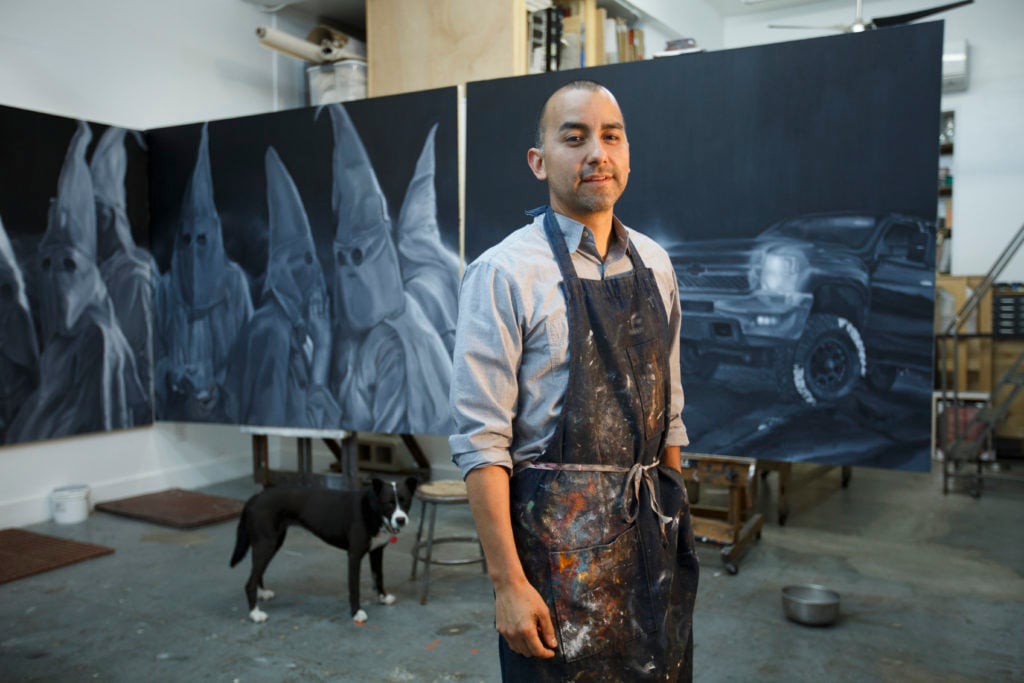
An anti-racist painting confronts the truth of white supremacy in the US.

Sarah Cascone

It’s not every day that an artist sets out to paint a 30-foot-long canvas filled with larger-than-life Ku Klux Klansmen staring ominously back at the viewer. And so, when the Blanton Museum of Art at the University of Texas at Austin purchased The City I from Vincent Valdez for $200,000, it knew it had to tread carefully.
“Art raises uncomfortable questions at times, but the rewards that come from having difficult conversations are many and important,” said Blanton director Simone Wicha in a statement. She called the “City” paintings “an exploration of racism, one of the most persistent and challenging social issues of our day.”
Valdez began his two-part “City” painting series in the fall of 2015, and the Blanton bought them the following year. (The City I is accompanied by The City II, depicting a pile of discarded mattresses and trash against the backdrop of a sprawling metropolis.)
At that point, former KKK leader David Duke had already made statements in support of the candidacy of Donald Trump, who hesitated to offer a full-throated condemnation of white supremacists during his campaign.
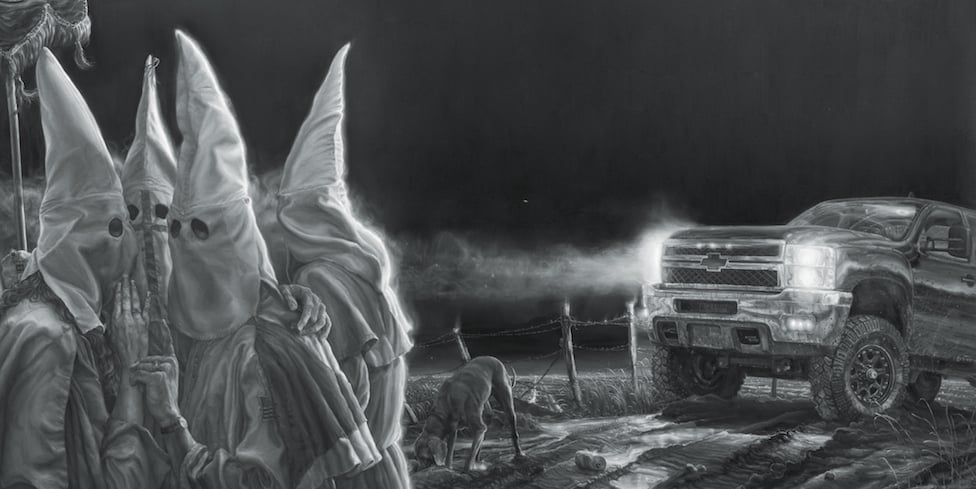
Vincent Valdez, The City I (2015–16), detail. Photo by Peter Molick, courtesy of the artist, David Shelton Gallery, and the Blanton Museum of Art at the University of Texas at Austin, purchase through the generosity of Guillermo C. Nicolas and James C. Foster with additional support from Jeanne and Michael Klein and Ellen Susman.
The artist had no way of knowing, however, how Trump’s election to the presidency would seemingly embolden racists groups and organizations, culminating in the deadly Unite the Right rally of white nationalists and neo-Nazis in Charlottesville, Virginia, in August of 2017. Somehow, Valdez had tapped into this undercurrent in American society, and the growing embrace of white nationalism, before it came bubbling up to the surface.
That violence is only alluded to in The City I. Valdez’s canvas depicts a modern-day KKK gathering, on the outskirts of an unidentified city. A late-model Chevy Silverado truck and a smartphone serve as markers that place this scene firmly in our own times, reminding the viewer that sadly, the KKK—and those who share its views—is not a relic of a bygone era.
“My work often relates to past events in American history that have been marginalized or silenced or entirely erased,” Valdez told artnet News. “With a large image in black and white, it’s very cinematic. Some viewers may glance at this and assume this is a haunting image of the Klan in 1939 in the American South, but when you look very closely, I lure you in with those details. It’s really critical that I blur that line between past and present.”
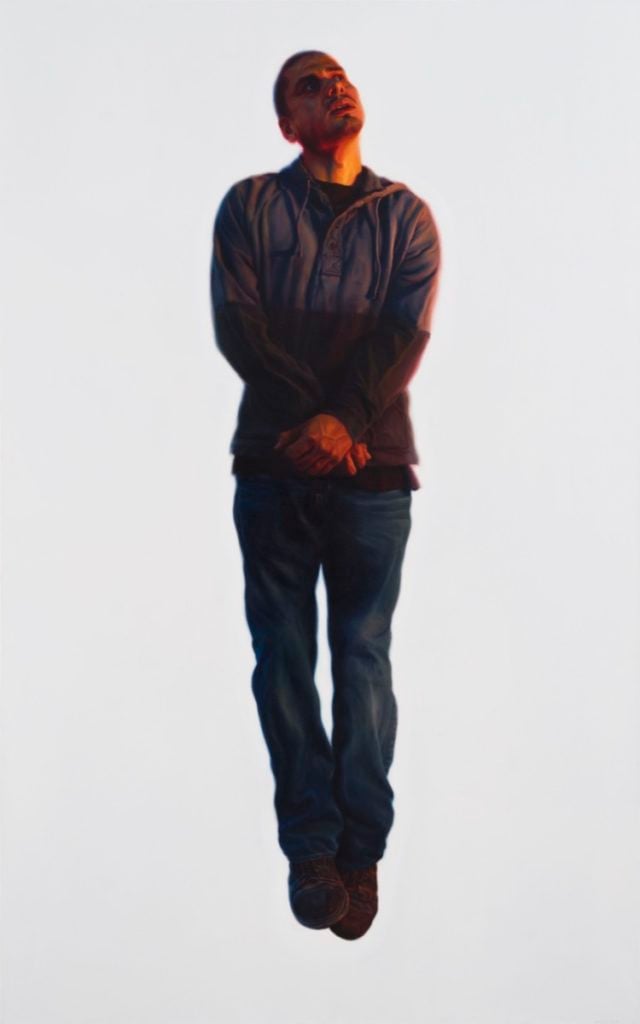
Vincent Valdez, Untitled, from the series “The Strangest Fruit” (2013). Courtesy of the Blanton Museum of Art ©Vincent Valdez.
The Blanton, which also owns two canvases from Valdez’s “The Strangest Fruit” series, inspired by the historical but generally forgotten lynching of Mexicans in the US, announced its acquisition of the two “City” paintings in July 2017, roughly a month before Charlottesville, but curators had already spent quite a bit of time thinking ahead to how the work might be received. The City I was shown in September at David Shelton Gallery in Houston, but the Blanton waited until this week, a year later than initially planned, to unveil the canvas.
As reported by the New York Times, the museum was extra cautious in presenting the piece, which it knew was potentially inflammatory. In order to prepare the community for the work, the Blanton and its faculty met with the Anti-Defamation League and the Austin school district and held roundtable discussions about the piece. It also reached out to local social justice groups, politicians, and other community leaders. (In an apparent oversight, however, it didn’t consult with the local NAACP chapter until earlier this month.)
“The painting calls us to gaze into the faces of evil and in so doing to gaze at ourselves—our capacity for hate and for violence, our collective history, and our fraught contemporary,” wrote Mónica A. Jiménez, from the school’s department of African and African diaspora studies. “Here is our American sublime: beautiful and terrible. We want to frantically turn away, but we cannot.”
We spoke with Valdez about what inspired these two works, the challenges inherent in tackling such a controversial subject, and about why he, as a Mexican American artist, felt qualified (and obligated) to offer artistic commentary about racism.
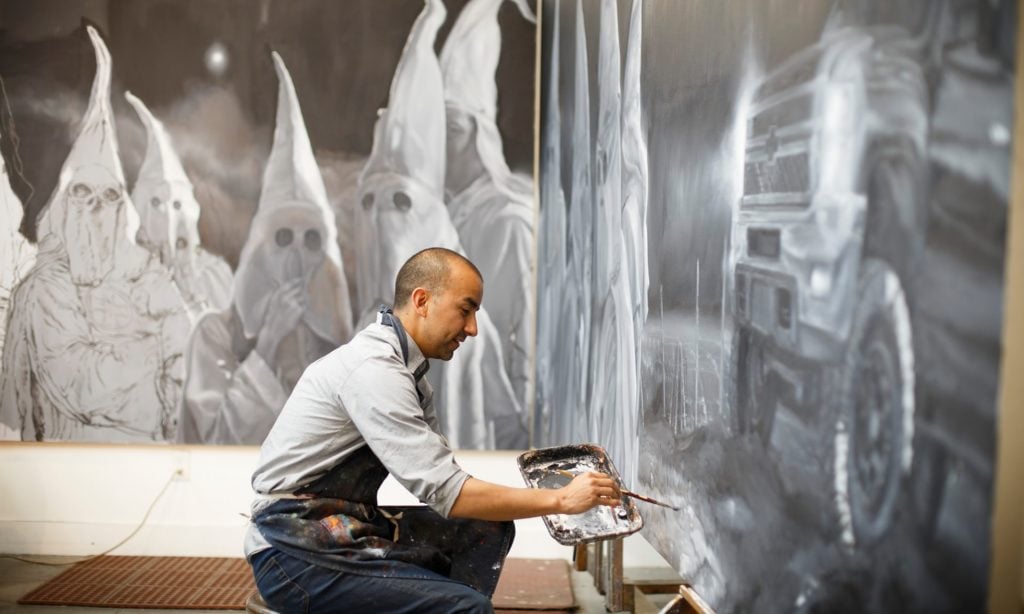
Vincent Valdez working on his painting The City I (2015–16) at his studio in San Antonio. Photo by Michael Stravato, courtesy of the Blanton Museum of Art at the University of Texas at Austin.
What inspired you to create this painting?
I started the “City” in 2015. At that time, you have to realize, [the issue of white supremacy] was relatively quiet as compared to now. This was my way of stepping up and asking the question “why is nobody talking about this elephant in the room?”
I was countering this moment when America was so very ready to coin itself a post-racial society. I feel very strongly that America still finds itself trapped between the myth of who we think we were and the reality of who we really are. Americans excel at avoiding looking into a truthful mirror, because of what it might reveal. The “City” is that mirror.
Can you tell us a little bit about how the composition came together and the creative process?
I was never interested in portraying a sinister, violent, representation of the Ku Klux Klan. Most Americans today assume that “these people” in Klan outfits, preaching and living the ideologies of hatred and racial violence, are only inarticulate uneducated people.
There’s something that pushes the envelope by portraying these Klan members as regular people. I wanted to suggest that after this gathering, they get back into their cars, they go home, they put their kids to bed, they make lunches for the morning… maybe they’re your neighbor watering the grass down the street the following day. I was trying to say “this is here, this is real, and this is not leaving any time soon.”
There definitely was a staring contest going on in the studio. I’d walk down there every day, late at night I’d be sitting there painting by myself and it almost became this game between myself and these larger than life figures who were taking shape; who was going to flinch first?
And what happened?
As I stand before this image today, neither side has flinched. There is something very powerful in this painting as my way of bearing witness to the realization that we are at a complete standstill in this country. We have fallen deep down into a rabbit hole where Americans are becoming very tribal. We are drawing lines between races, classes, cultures, politics, and religions.
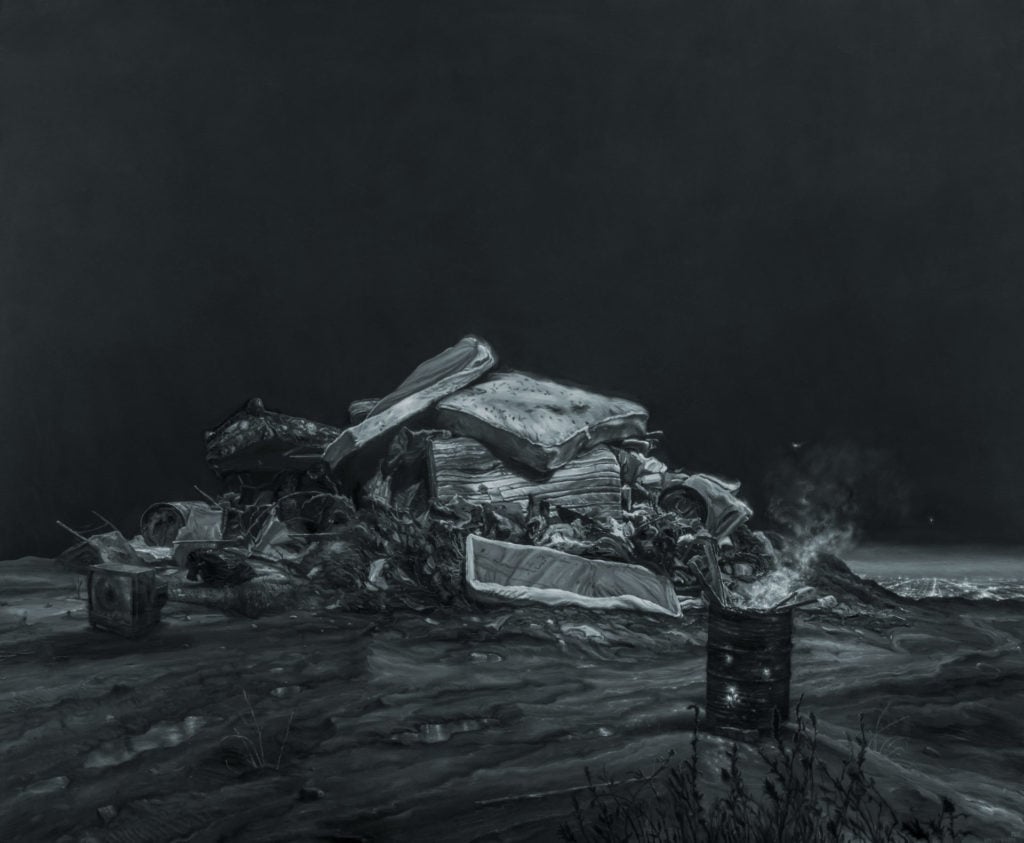
Vincent Valdez, The City II (2016). Photo by Peter Molick, courtesy of the artist, David Shelton Gallery, and the Blanton Museum of Art at the University of Texas at Austin, purchase through the generosity of Guillermo C. Nicolas and James C. Foster with additional support from Jeanne and Michael Klein and Ellen Susman.
What is the significance of the second painting in the “City” series?
The City II is way more subliminal than the main panel. It gives a much wider view and perspective of both overt and covert racism in America. If you look beyond the trash—the discarded TVs, piles of shoes, old mattresses, a very sludgy, almost toxic mud puddle—at the foundation of this landscape, about 45 feet below all that, you drop into this promised land, this golden, glowing metropolis of light.
It was really important to me that this could be Los Angeles, Houston, New York City, Chicago… any large city in modern-day America. I wanted to encourage the viewer to take a more panoramic, wider perspective, and to think critically about the ways that racism exists in our cities today. The ways that most American cities are designed and planned—whether you’re in Texas, the Northeast, or on the West Coast—they are are still very segregated.
If you think about where schools are placed, who has access to education; where county jailhouses or courtrooms are located; or junkyards, railroad tracks, industrial sectors, dumping grounds—even down to the placement of parks and trees—there is something very very sinister in the way urban planning keeps populations divided by both race and class. It’s a powerful and destructive factor in the American landscape.
Do you feel as those the painting is prescient, having been painted before the events of Charlottesville?
When I started in 2015, Richard Spencer and the “alt-right” movement were not on the television and in news headlines every day like they have been recently. In my career and studio practice, I had never encountered a painting that was literally coming to life in the real world outside of the studio doors. As the election started to pick up, it was everywhere, even just in terms of the vocabulary and the language that was being used and becoming normalized.

Vincent Valdez, The City I (2015–16). Photo by Peter Molick, courtesy of the artist, David Shelton Gallery, and the Blanton Museum of Art at the University of Texas at Austin, purchase through the generosity of Guillermo C. Nicolas and James C. Foster with additional support from Jeanne and Michael Klein and Ellen Susman.
Is it difficult, emotionally, to work on a painting like this?
The reality is that the subjects that I’ve always tackled in the studio have always dealt with very critical challenging subjects. In 2015 and ’16, I was far more disturbed by the reality of this image in the real world, the fact that this [the KKK] was was still here.
Were you surprised that a museum was interested in acquiring such a challenging piece? How did the curators react when they first saw it?
When I’m making these things, they’re really for me and my mission to bring light to the subjects. I don’t allow myself to think about their life past when they’re here in the studio. But the few people who had access to the studio while it was in progress all had the same reaction: Everybody just stopped dead in their tracks because of the sheer scale but also because of the subject.
How did you work with the museum to present the painting responsibly?
It’s my job to execute the work and it’s my responsibility to provide as much information as I can in regards to the work and its process, research, materials, and subject. I felt really good about handing that material over and just being available to them.
As far as the educational programming, I was informed throughout about plans, ideas, and strategies, but that’s not my area of expertise. And I’m also tied up in the studio. Once these things leave the studio they take on a life of their own. At a certain point, I don’t have any control over how they are received.
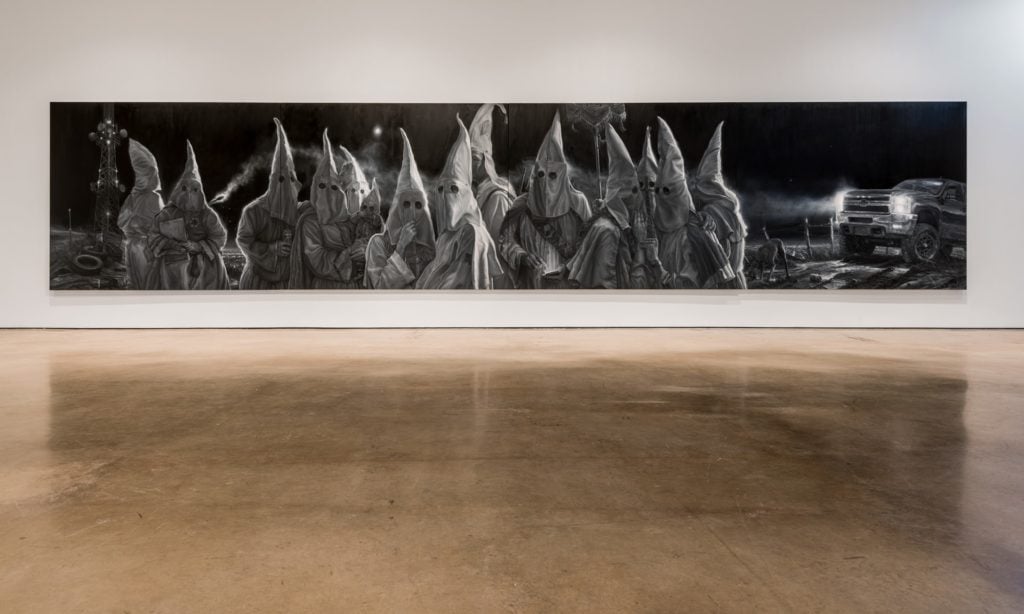
Vincent Valdez, The City I (2015–16). Photo by Peter Molick, courtesy of the artist, David Shelton Gallery, and the Blanton Museum of Art at the University of Texas at Austin, purchase through the generosity of Guillermo C. Nicolas and James C. Foster with additional support from Jeanne and Michael Klein and Ellen Susman.
Some people feel that issues of racism can only be addressed by artists of African descent. What would you say to them in response?
Thank you for asking me that question. I’m a Mexican American artist. I’m an artist of color. Throughout its history, the Ku Klux Klan has placed many Americans in their crosshairs. Written into their creed is their anti-immigration stance. They have targeted African Americans, of course, but also Jewish Americans, gay Americans, and other white Americans.
Mexican Americans are usually only provided a platform when it pertains to immigration and border policies in this country. Rarely do we see a Latino being asked how they feel about health care, or how they might be affected by racism, or how they might feel threatened by an image of white supremacists walking down the streets of Charlottesville.
In my research, I found that Latino artists really haven’t been recognized by institutions and the art history textbooks as being part of this dialogue. It was extremely important to me as an artist and citizen and Mexican American to give myself a platform and insert myself into a long legacy of artists who have addressed the subject of racism in this country.
This was my way of picking up that torch and saying I stand in solidarity with my African American brothers and sisters who have been at the brutal receiving end of racism. I also stand in solidarity with [other] people of color and any American who has felt morally obligated to stand up and speak up.
Are there any particular artists or works that inspired you to take on the Klan so directly?
In the publication we produced for the “City,” I talk about Philip Guston and his 1969 painting City Limits, which features these cartoonish Mickey Mouse Klansman that he used for about a decade in his work, and Gil Scott-Heron, an amazing African American poet and activist who addressed the Klan with his 1980 song “The Klan.”
So Valdez, Guston, and Scott-Heron. Here are three different Americans of three different generations from three different ethnic backgrounds. My question is how many more American artists after me will be forced to recognize and address the issue of white supremacism and racism in this country? When will enough be enough?
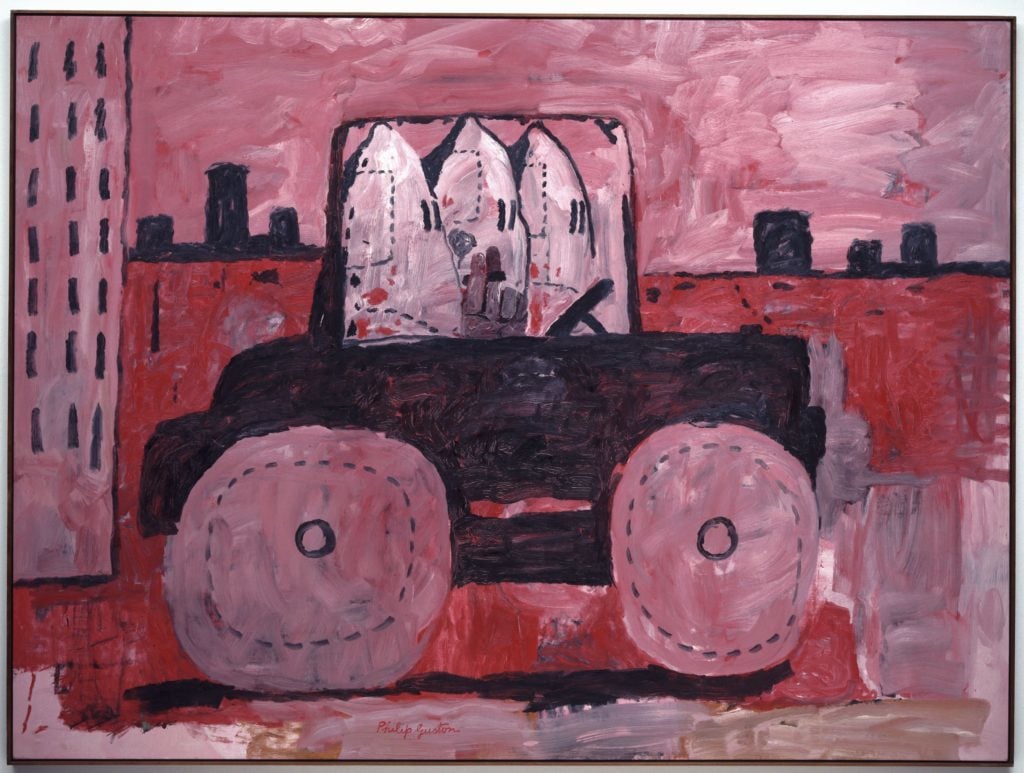
Philip Guston, City Limits (1969). Courtesy of the Museum of Modern Art, gift of Musa Guston, ©the Estate of Philip Guston and the Museum of Modern Art, licensed by SCALA/Art Resource, NY.
What do you hope that visitors to the museum take away from the “City” paintings?
It is my hope that viewers will take a moment to just think a little bit more critically in which ways I am using a very obvious and recognizable symbol of racial hatred and violence. When you pair the image of the Klan with the title of the painting, I hope it will make viewers wonder about how this subject is so deeply embedded in our American DNA.
We are all spokes in a much larger wheel of white supremacy that has shaped capitalism and political policies over the past two and a half centuries. You don’t have to look very far. Turn on the television set, look at the front page of the newspaper every single morning. Nobody can deny that racism and white supremacy has really infected every corner of America.
This interview has been edited and condensed for clarity.
“Vincent Valdez: The City” is on view at the Blanton Museum of Art at the University of Texas at Austin, 200 East Martin Luther King Jr. Boulevard, Austin, July 17, 2018–October 28, 2018.